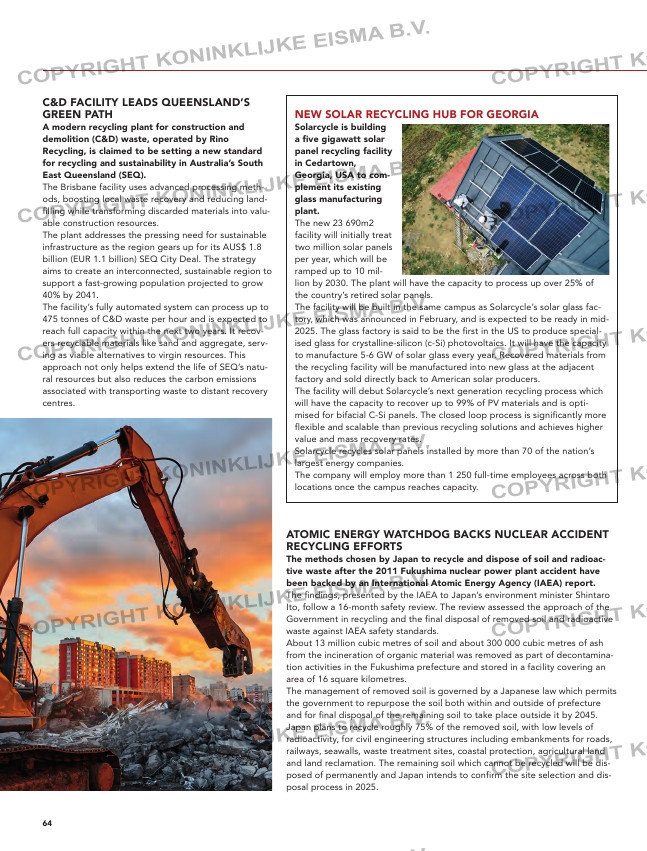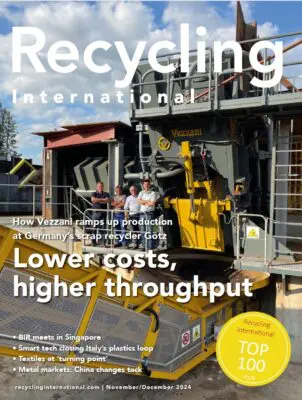Page 64 from: Recycling International November/December issue 2024

64
ATOMIC ENERGY WATCHDOG BACKS NUCLEAR ACCIDENT
RECYCLING EFFORTS
The methods chosen by Japan to recycle and dispose of soil and radioac-
tive waste after the 2011 Fukushima nuclear power plant accident have
been backed by an International Atomic Energy Agency (IAEA) report.
The findings, presented by the IAEA to Japan’s environment minister Shintaro
Ito, follow a 16-month safety review. The review assessed the approach of the
Government in recycling and the final disposal of removed soil and radioactive
waste against IAEA safety standards.
About 13 million cubic metres of soil and about 300 000 cubic metres of ash
from the incineration of organic material was removed as part of decontamina-
tion activities in the Fukushima prefecture and stored in a facility covering an
area of 16 square kilometres.
The management of removed soil is governed by a Japanese law which permits
the government to repurpose the soil both within and outside of prefecture
and for final disposal of the remaining soil to take place outside it by 2045.
Japan plans to recycle roughly 75% of the removed soil, with low levels of
radioactivity, for civil engineering structures including embankments for roads,
railways, seawalls, waste treatment sites, coastal protection, agricultural land
and land reclamation. The remaining soil which cannot be recycled will be dis-
posed of permanently and Japan intends to confirm the site selection and dis-
posal process in 2025.
LATVIA BOASTS MAJOR NEW PET RECYCLING
PLANT
One of the largest PET recycling facilities in northern
Europe has opened at Olaine, Latvia.
Iterum’s new site has a planned processing capacity of 80
000 tonnes per year, about 30% more than was possible at
the company’s previous production facility in Jelgava. Iterum
has invested more than EUR 10 million the new factory while
the total investment exceeds EUR 35 million.
The newly opened factory is one of the biggest industrial
buildings in Latvia with a total indoor area of approximately
30 000 square metres and an outdoor area of approximately
40 000 square metres. Suppliers include the Austrian manu-
facturer Starlinger.
Iterum says the level of the equipment at the new facility has
been installed in only two other production plants in Europe
and 10 across the world. ‘Thus, the plant will also be techno-
logically one of the most modern PET processing plants in
Europe and the world.”
The initiative is expected to help boost the Latvian recycling
rate from its current level of less than 50%.
NEW SOLAR RECYCLING HUB FOR GEORGIA
Solarcycle is building
a five gigawatt solar
panel recycling facility
in Cedartown,
Georgia, USA to com-
plement its existing
glass manufacturing
plant.
The new 23 690m2
facility will initially treat
two million solar panels
per year, which will be
ramped up to 10 mil-
lion by 2030. The plant will have the capacity to process up over 25% of
the country’s retired solar panels.
The facility will be built in the same campus as Solarcycle’s solar glass fac-
tory, which was announced in February, and is expected to be ready in mid-
2025. The glass factory is said to be the first in the US to produce special-
ised glass for crystalline-silicon (c-Si) photovoltaics. It will have the capacity
to manufacture 5-6 GW of solar glass every year. Recovered materials from
the recycling facility will be manufactured into new glass at the adjacent
factory and sold directly back to American solar producers.
The facility will debut Solarcycle’s next generation recycling process which
will have the capacity to recover up to 99% of PV materials and is opti-
mised for bifacial C-Si panels. The closed loop process is significantly more
flexible and scalable than previous recycling solutions and achieves higher
value and mass recovery rates.
Solarcycle recycles solar panels installed by more than 70 of the nation’s
largest energy companies.
The company will employ more than 1 250 full-time employees across both
locations once the campus reaches capacity.
C&D FACILITY LEADS QUEENSLAND’S
GREEN PATH
A modern recycling plant for construction and
demolition (C&D) waste, operated by Rino
Recycling, is claimed to be setting a new standard
for recycling and sustainability in Australia’s South
East Queensland (SEQ).
The Brisbane facility uses advanced processing meth-
ods, boosting local waste recovery and reducing land-
filling while transforming discarded materials into valu-
able construction resources.
The plant addresses the pressing need for sustainable
infrastructure as the region gears up for its AUS$ 1.8
billion (EUR 1.1 billion) SEQ City Deal. The strategy
aims to create an interconnected, sustainable region to
support a fast-growing population projected to grow
40% by 2041.
The facility’s fully automated system can process up to
475 tonnes of C&D waste per hour and is expected to
reach full capacity within the next two years. It recov-
ers recyclable materials like sand and aggregate, serv-
ing as viable alternatives to virgin resources. This
approach not only helps extend the life of SEQ’s natu-
ral resources but also reduces the carbon emissions
associated with transporting waste to distant recovery
centres.
64-65-66-67_trendsupdatesiiad.indd 64 21-11-2024 08:46



